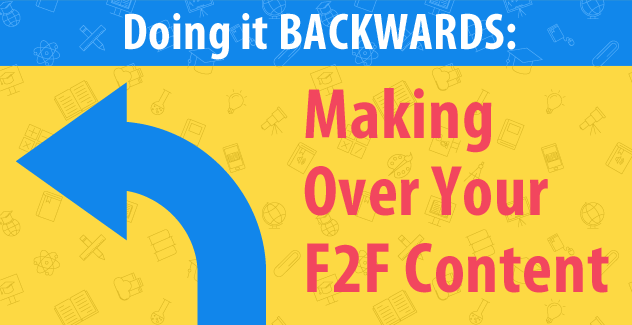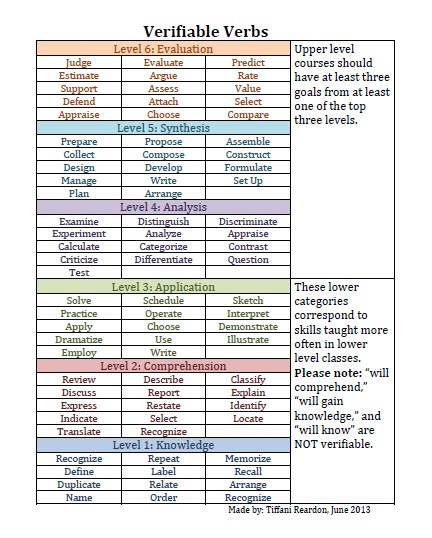
For educators interested in teaching online, the question of where to begin is always at the forefront. There are so many resources available and knowing what the first step is can seem impossible. This is the second in a 3-part blog series from Laura Howard, sharing her knowledge and experiences in teaching online from where to start, to making over existing assignments and establishing your own process. The first post focused on ‘Where to Start’ and the benefits on teaching online as well as resources you may have available at your institution. This second post focuses on making over existing content, previously used for face-to-face (F2F) instruction, for online use.
Doing it Backwards: Making Over Your F2F Content
Depending on your discipline, you might not have received much instructional design training. Instructional design principles, however, make the process of developing online courses much easier and systematic, while still allowing agency to practice your own pedagogy. It is important to acquaint yourself with instructional design best practices that will help you achieve your online teaching goals. A concept I find particularly helpful is backward design.
Backward design is an idea popularized by Wiggins and McTighe in their 2000 book, Understanding by Design. The concept assumes that most instructors approach course design in a “forward” manner, beginning with activities they plan to assign. Backward design puts learning objectives first. By identifying specific, measurable learning objectives at the outset, instructors can plan meaningful activities that lead to thoughtfully organized and sequenced course content.
When making over F2F content for the online classroom, consider that assignments in their current form may not be aligned with learning objectives for a particular unit or course. Take a step back and identify specifically what learners should achieve in each module or week of the course. I typically compose three learning objectives per module or week of an online class, then I create activities to support them. Always check to be sure that learning objectives begin with verifiable verbs, meaning they can be measured and assessed. Verifiable verbs, a concept based on Bloom’s taxonomy, are essential components of intentional course design. To aid in course design, I keep a list handy in my office.
| The Office of Distance Learning at Kennesaw State University offers a fantastic chart put together by instructional designer extraordinaire, Tiffani Reardon. |  |
Some learning objectives I use in my own courses have included the following:
- Propose a rhetorical analysis essay based on a text of your choice;
- Analyze a political cartoon for examples of ethos, logos, and pathos; and,
- Compare a popular source and an academic journal article on the same research topic.
Remember, first write an objective that relates to course outcomes, then revise your f2f assignments to support this objective. All objectives in the course should be measurable, and all course activities should match or align with objectives.
Once you have identified course objectives and related activities and assignments, you should also consider whether your activities and assignments are appropriate for the online classroom. A good place to start in making this determination is to analyze your audience. Who are your students? What are their needs, expectations, and goals? How does your assignment engage your audience and help create a sense of community in the online classroom? If it doesn’t, consider revising it to be more collaborative, interactive, or otherwise effective. If you have decided to use a content-authoring tool like SoftChalk, you might want to explore some of its features that will help you add interactive elements to your course. Remember that visual design counts, too: use SoftChalk to redesign your assignments in a way that reflects your teaching persona and appeals to learners visually.
Finally, stay current on instructional design trends and scholarship, as well as scholarship about distance learning in your field. There are many scholarly and popular sources for information on instructional design best practices. Blogs like this one are also a great resource for engaging posts by instructors practicing these techniques across the globe. Developing a process for online course design that begins with measurable objectives and thoughtfully aligned activities will put you and your students on the path toward success.
Final post:
Establishing Your Online Design and Teaching Process
 Laura Howard, PhD, is a Lecturer in English at Kennesaw State University, near Atlanta, Georgia. She has been teaching hybrid and online courses for more than a decade, and she currently serves as the online technology coordinator for her department, training and supporting English faculty teaching hybrid and online courses. Her areas of interest include composition pedagogy, online writing instruction, professional writing pedagogy, research methods, and social justice. She can be reached at lhowar40@kennesaw.edu.
Laura Howard, PhD, is a Lecturer in English at Kennesaw State University, near Atlanta, Georgia. She has been teaching hybrid and online courses for more than a decade, and she currently serves as the online technology coordinator for her department, training and supporting English faculty teaching hybrid and online courses. Her areas of interest include composition pedagogy, online writing instruction, professional writing pedagogy, research methods, and social justice. She can be reached at lhowar40@kennesaw.edu.

Leave a Reply